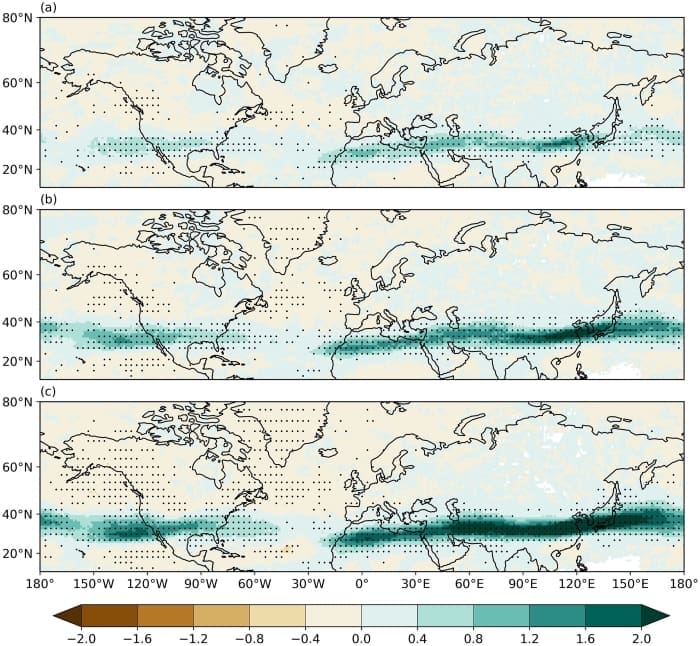Disruptive clear air turbulence is predicted to increase over most northern mid-latitude regions.
A type of invisible, unpredictable air turbulence is expected to occur more frequently in the Northern Hemisphere as the climate warms, according to new research. Known as clear air turbulence, the phenomenon also increased in the Northern Hemisphere between 1980 and 2021, the study found.
The research follows up on recent work predicting increases in moderate-to-severe clear air turbulence by analyzing extensive data sets and running comprehensive model simulations. The study was published in Journal of Geophysical Research: Atmospheres, an open-access AGU journal that publishes research advancing the understanding of Earth’s atmosphere and its interaction with other components of the Earth system.
The results suggest clear air turbulence will increase in most regions affected by the jet stream, especially over North Africa, East Asia and the Middle East, and that the probability of clear air turbulence will increase with each degree of warming. While most people expect turbulence when flying in an airplane through a thunderstorm or over a mountain range, clear air turbulence hits aircraft unexpectedly. And unlike other, more obvious types of turbulence, there is no easy way to detect and avoid clear air turbulence.
“We know that clear air turbulence is the main cause of aviation turbulence, which causes approximately 70% of all weather-related accidents over the United States,” said Mohamed Foudad, an atmospheric scientist at the University of Reading and the study’s lead author. Recent well-publicized encounters with clear air turbulence caused injuries on Singapore Airlines and Air Europa flights.
Foudad added that aviation engineers should account for an increase in turbulence when designing aircraft in the future.
“We now have high confidence that climate change is increasing clear air turbulence in some regions,” he said.
Analyzing the air
Most clear air turbulence occurs near jet streams: fast-moving, west-to-east air currents in the upper troposphere, where commercial planes fly, around 10-12 kilometers (approximately 32,000-39,000 feet) above Earth’s surface. Sometimes, planes flying through jet streams encounter spikes of volatile, upwards-moving air called vertical wind shear, creating the phenomenon of clear air turbulence.
As the climate warms, the amount of energy in the atmosphere will grow, increasing both the velocity of jet streams and the number of vertical wind shears. Those increases mean that clear air turbulence, which planes currently encounter about 1% of the time in the Northern Hemisphere, is expected to become more common in the future. Currently, clear air turbulence is most frequent over East Asia, where the subtropical jet stream is the strongest and where planes can expect to encounter moderate-to-severe clear air turbulence approximately 7.5% of the time.
Foudad and his colleagues used 11 climate models to determine past and future changes in clear air turbulence. To find future trends, the researchers performed 20 computer simulations under potential future warming increases of 1 degree Celsius (corresponding to current warming) to 4 degrees Celsius.

In most regions of the Northern Hemisphere affected by the jet stream, air turbulence will increase. In regions where clear air turbulence will increase the most, the study’s models agreed the most, which Foudad said indicates high confidence in the results. Past studies predicted increases in clear air turbulence over the North Atlantic in the future, but the new study was inconclusive for the region.
By reanalyzing atmospheric data from 1980 to 2021, the researchers found that moderate-to-severe clear air turbulence increased between approximately 60% and 155% over North Africa, East Asia, the Middle East, the North Atlantic and the North Pacific over the 41-year interval.
While past increases over North Africa, East Asia and the Middle East can be attributed to climate change, the researchers could not chalk up increases over the North Atlantic and the North Pacific to human-caused warming. Instead, climate variability in those regions could be hiding the signs of climate change’s effects.
Dangerous impacts of invisible turbulence
Clear air turbulence is difficult and expensive to forecast, and an increase in turbulence could pose a problem for aircraft safety.
The researchers note that further analyses could determine whether future flights might be safer at either higher or lower altitudes than the current norm. But while airline passengers may have bumpier rides in the future, modern aircraft are built to withstand strong turbulence.
“We will see more of these accidents, but people should also be aware that aircraft are designed to resist the worst turbulence that could happen,” Foudad said.
***
AGU (www.agu.org) is a global community supporting more than half a million advocates and professionals in Earth and space sciences. Through broad and inclusive partnerships, AGU aims to advance discovery and solution science that accelerate knowledge and create solutions that are ethical, unbiased and respectful of communities and their values.
More information: Mohamed Foudad, Emilia Sanchez-Gomez, Thomas Jaravel, Mélanie C. Rochoux, Laurent Terray, ‘Past and Future Trends in Clear-Air Turbulence Over the Northern Hemisphere’, Journal of Geophysical Research Atmospheres (vol. 129, Iss. 13; 2024); DOI: 10.1029/2023JD040261 | AGU Press Release/Material. Featured image credit: Pixabay | Pexels




